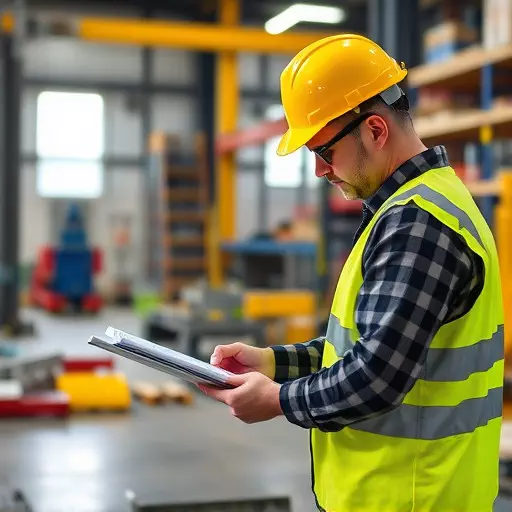TL;DR:
Onsite Environmental Health and Safety (EHS) services are essential for identifying and mitigating risks in confined spaces. They conduct thorough inspections, analyze atmospheric conditions, structural integrity, and hazardous materials using hazard identification and risk assessment methods. Workplace safety audits uncover potential dangers like oxygen deficiency and toxic gases, enabling employers to implement control measures and robust safety protocols. Regular audits foster a culture of safety, significantly reducing accidents and injuries in confined environments while adhering to regulatory standards. Onsite EHS services, workplace safety audits, and hazard identification and risk assessment are key to ensuring worker protection, compliance, and operational efficiency.
Confined space entry evaluations are a critical component of workplace safety, especially in industries where workers frequently encounter tight, enclosed, or partially enclosed areas. This comprehensive guide explores various aspects of confined space assessments, from hazard identification through risk assessment and implementation of control measures. Onsite EHS services play a pivotal role in navigating these challenges, ensuring compliance and maximizing safety during entry procedures. Leveraging workplace safety audits, organizations can identify risks, implement best practices, and continuously improve their confined space programs.
- Understanding Confined Space Entry Evaluations
- The Role of Onsite EHS Services in Hazard Identification
- Workplace Safety Audits: A Comprehensive Approach to Risk Assessment
- Identifying Hazards in Confined Spaces: Key Considerations
- Conducting Risk Assessments for Safe Entry
- Implementing Control Measures and Safe Work Practices
- Continuous Improvement: Monitoring and Updating Evaluations
Understanding Confined Space Entry Evaluations
Confined space entry evaluations are critical components of onsite EHS (Environmental Health and Safety) services, ensuring that workplaces adhere to stringent safety standards. These evaluations involve a thorough inspection and analysis of areas that are confined or limited in accessibility, such as small chambers, tanks, or narrow passageways. The primary goal is to identify potential hazards and conduct a risk assessment to mitigate any dangers associated with entry or work in these spaces.
Onsite EHS professionals employ various techniques, including hazard identification and risk assessment methods, to navigate through these challenging environments. They assess the unique challenges posed by confined spaces, such as limited oxygen supply, potential toxic gases, or the risk of entrapment. Through comprehensive workplace safety audits, they ensure that appropriate control measures are in place, providing a safe entry and work procedure for employees while minimizing risks to health and life.
The Role of Onsite EHS Services in Hazard Identification
Onsite EHS (Environmental Health and Safety) services play a pivotal role in identifying hazards within confined spaces. These professionals are equipped with the knowledge and expertise to conduct thorough workplace safety audits, ensuring every potential risk is uncovered. Through meticulous assessments, they evaluate various factors such as atmospheric conditions, structural integrity, and the presence of hazardous materials or energy sources. This comprehensive approach allows for accurate hazard identification, which is a crucial step in mitigating risks associated with confined spaces.
By integrating onsite EHS services, organizations can benefit from expert insights that go beyond standard training. These audits enable proactive measures by identifying areas requiring improvements in ventilation, personal protective equipment (PPE) guidelines, or emergency response protocols. Regular hazard identification and risk assessment conducted by such services contribute to fostering a safer workplace culture, ultimately reducing the likelihood of accidents and injuries in confined environments.
Workplace Safety Audits: A Comprehensive Approach to Risk Assessment
Workplace Safety Audits play a pivotal role in identifying potential hazards and conducting thorough risk assessments for confined spaces. These audits, delivered by specialized onsite EHS (Environmental Health & Safety) services, encompass a systematic examination of various factors within a workplace environment. By meticulously scanning every aspect from physical structures to operational procedures, these audits ensure that all possible risks are uncovered and adequately addressed.
Through meticulous observation and data collection, workplace safety audits facilitate the early detection of hazards related to confined spaces, such as oxygen deficiency, toxic gases, or entrapment dangers. Armed with this information, employers can implement targeted control measures and establish robust safety protocols tailored to specific high-risk areas. Regular audits also foster a culture of continuous improvement, encouraging organizations to stay proactive in safeguarding their workforce and promoting adherence to the highest health and safety standards.
Identifying Hazards in Confined Spaces: Key Considerations
Identifying hazards in confined spaces is a critical step in ensuring workplace safety. Onsite EHS services play a pivotal role in conducting thorough hazard identification and risk assessment for such environments. These spaces, often characterized by limited accessibility and poor ventilation, can pose unique risks to workers’ health and safety. A comprehensive evaluation involves meticulously scrutinizing every aspect of the confined area, including physical attributes, previous incidents (if any), and potential dangers associated with the tasks to be performed.
During a workplace safety audit, experts from these services consider various factors such as the presence of toxic substances, hazardous atmospheres, or physical hazards like protruding objects or uneven surfaces. They also evaluate if there are any historical data on incidents related to confined spaces, which can offer valuable insights into recurring risks. This meticulous process is essential for developing effective safety protocols and implementing necessary controls to mitigate risks before workers enter these spaces.
Conducting Risk Assessments for Safe Entry
Before any confined space entry, conducting a thorough risk assessment is paramount to ensure worker safety. This process involves identifying potential hazards present in the space, such as toxic gases, limited oxygen, or hazardous materials, through onsite EHS services and workplace safety audits. By systematically evaluating these risks, companies can implement appropriate control measures.
Hazard identification and risk assessment are crucial steps in mitigating dangers. This includes considering historical data on past incidents, worker feedback, and regular maintenance records. These insights enable businesses to conduct comprehensive risk assessments, enabling them to establish safe entry procedures tailored to each confined space’s unique challenges.
Implementing Control Measures and Safe Work Practices
Implementing effective control measures and safe work practices is paramount in confined space entry evaluations. Onsite EHS services play a crucial role in ensuring these processes are not only implemented but also regularly audited and updated. Workplace safety audits, conducted by trained professionals, help identify potential hazards and assess existing risk management strategies. Through these audits, companies can uncover hidden risks, ensure compliance with regulatory standards, and foster a culture of continuous improvement in workplace safety.
Hazard identification and risk assessment are fundamental steps in this process. By meticulously identifying all possible hazards within confined spaces, such as toxic gases, limited oxygen, or structural instability, EHS experts can recommend appropriate control measures. These may include the use of specialized equipment, strict entry procedures, and personal protective gear. Regular reviews and adjustments to these controls ensure that workplace safety remains a top priority in dynamic work environments.
Continuous Improvement: Monitoring and Updating Evaluations
Continuous improvement is a vital aspect of confined space entry evaluations. Regularly monitoring and updating these assessments ensures that onsite EHS services remain effective and aligned with the evolving workplace safety landscape. By conducting periodic audits, organizations can identify new hazards or risks not previously considered and adjust their strategies accordingly. This proactive approach fosters a culture of safety by demonstrating a commitment to constant refinement based on real-world data and best practices.
Through comprehensive workplace safety audits, companies can systematically review existing procedures, engage employees, and gather insights from experienced professionals. This collaborative process facilitates hazard identification and risk assessment, enabling data-driven decisions that optimize worker protection. By staying current with industry trends and regulatory changes, onsite EHS services can help organizations maintain compliance and enhance overall operational efficiency.


